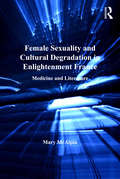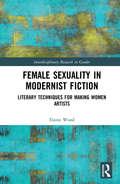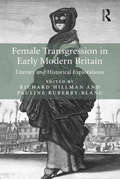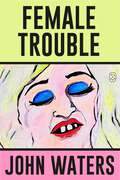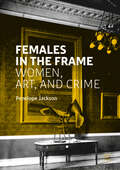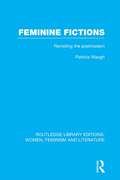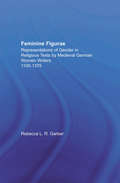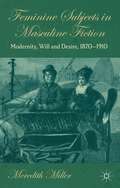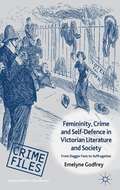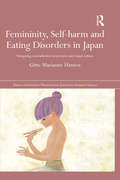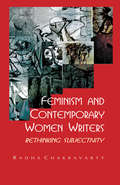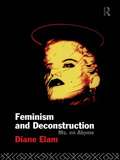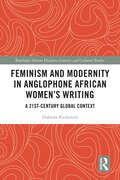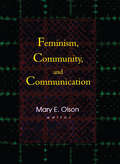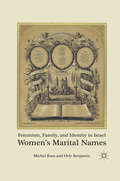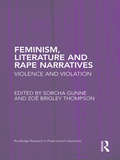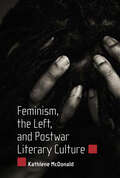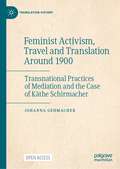- Table View
- List View
Female Sexuality and Cultural Degradation in Enlightenment France: Medicine and Literature
by Mary McAlpinIn her study of eighteenth-century literature and medical treatises, Mary McAlpin takes up the widespread belief among cultural philosophers of the French Enlightenment that society was gravely endangered by the effects of hyper-civilization. McAlpin's study explores a strong thread in this rhetoric of decline: the belief that premature puberty in young urban girls, supposedly brought on by their exposure to lascivious images, titillating novels, and lewd conversations, was the source of an increasing moral and physical degeneration. In how-to hygiene books intended for parents, the medical community declared that the only cure for this obviously involuntary departure from the "natural" path of sexual development was the increased surveillance of young girls. As these treatises by vitalist and vitalist-inspired physiologists became increasingly common in the 1760s, McAlpin shows, so, too, did the presence of young, vulnerable, and virginal heroines in the era's novels. Analyzing novels by, among others, Jean-Jacques Rousseau, Denis Diderot, and Choderlos de Laclos, she offers physiologically based readings of many of the period's most famous heroines within the context of an eighteenth-century discourse on women and heterosexual desire that broke with earlier periods in recasting female and male desire as qualitatively distinct. Her study persuasively argues that the Western view of women's sexuality as a mysterious, nebulous force-Freud's "dark continent"-has its secular origins in the mid-eighteenth century.
Female Sexuality in Modernist Fiction: Literary Techniques for Making Women Artists (Interdisciplinary Research in Gender)
by Elaine WoodFemale Sexuality in Modernist Fiction: Literary Techniques for Making Women Artists provides a chronological investigation of the innovative writing styles of canonical modernist writers to reveal a shift in gendered representations of sexual subjectivity. Positioned at the nexus of studies on the body and sexuality in modernist literature, this book addresses the complex ways that constructions of female sexuality are understood culturally, politically, and epistemologically. Using close reading strategies to identify how modernist authors challenge representations of female positionality as passive, case studies consider how canonical modernist authors – Virginia Woolf, W.B. Yeats, James Joyce, and Samuel Beckett – found new ways to represent women as embodied, sexual, desired, and desiring subjects through prose, poetry, and drama. This book addresses Woolf’s Orlando: A Biography (1928), Yeats’ The Winding Stair and Other Poems (1933), Joyce’s Finnegans Wake (1939), Beckett’s Not I (1972), and other dramatic works. By rendering sexuality more obviously as a component of female character, these works of modernist literature shape our understanding of the artistic body as a structure for thinking about "woman" as a linguistic construct and material reality. This study is will be of great interest to scholars in English literature, women and gender studies, and sexuality studies.
Female Transgression in Early Modern Britain: Literary and Historical Explorations
by Richard Hillman Pauline Ruberry-BlancPresenting a broad spectrum of reflections on the subject of female transgression in early modern Britain, this volume proposes a richly productive dialogue between literary and historical approaches to the topic. The essays presented here cover a range of ’transgressive’ women: daughters, witches, prostitutes, thieves; mothers/wives/murderers; violence in NW England; violence in Scotland; single mothers; women as (sexual) partners in crime. Contributions illustrate the dynamic relation between fiction and fact that informs literary and socio-historical analysis alike, exploring female transgression as a process, not of crossing fixed boundaries, but of negotiating the epistemological space between representation and documentation.
Female Trouble: A Screenplay
by John Waters“Burroughs famously dubbed Waters the Pope of Trash. Female Trouble, we might say, is his Summa Trashologica.”—Ed Halter, The Criterion CollectionIt all goes to hell when Baltimore bad girl Dawn Davenport doesn’t get the cha-cha heels she’s been demanding for Christmas. In this hilarious, irreverent, pyrotechnic melee of high-trash hijinks, Dawn ruins Christmas, skips town, and embarks on a wild ride that involves hitchhiking, robbery, murder, pregnancy—and, of course, modeling and glamour, too. The second installment of John Waters’ classic Trash Trilogy, Female Trouble explodes conventional norms of good behavior (and art) and is all the proof you’ll ever need that sometimes being bad can feel so, so very good.
Females in the Frame: Women, Art, and Crime
by Penelope JacksonThis book explores the untold history of women, art, and crime. It has long been widely accepted that women have not played an active role in the art crime world, or if they have, it has been the part of the victim or peacemaker. Women, Art, and Crime overturns this understanding, as it investigates the female criminals who have destroyed, vandalised, stolen, and forged art, as well as those who have conned clients and committed white-collar crimes in their professional occupations in museums, libraries, and galleries. Whether prompted by a desire for revenge, for money, the instinct to protect a loved one, or simply as an act of quality control, this book delves into the various motivations and circumstances of women art criminals from a wide range of countries, including the UK, the USA, New Zealand, Romania, Germany, and France. Through a consideration of how we have come to perceive art crime and the gendered language associated with its documentation, this pioneering study questions why women have been left out of the discourse to date and how, by looking specifically at women, we can gain a more complete picture of art crime history.
Feminine Fictions: Revisiting the Postmodern (Routledge Library Editions: Women, Feminism and Literature)
by Patricia Waugh‘Postmodernism’ and ‘feminism’ have become familiar terms since the 1960s, developing alongside one another and clearly sharing many strong points of contact. Why then have the critical debates arising out of these movements had so little to say about each other? Patricia Waugh addresses the relationship between feminist and postmodernist writing and theory through the insights of psychoanalysis and in the context of the development of modern fiction in Britain and America. She attempts to uncover the reasons why women writers have been excluded from the considerations of postmodern art. Her route takes her through the theorization of self offered by Freud and Lacan and on to the concept of subjectivity articulated by Kleinian and later object-relations psychoanalysts. She argues that much women’s writing has been inappropriately placed and interpreted within a predominantly formalist-orientated aesthetic and a post-Freudian/liberal, individualist conceptualization of subjectivity and artistic expression. This tendency has been intensified in discussions of postmodernism, and a new feminist aesthetic is thus badly needed. In the second part of the book Patricia Waugh analyses the work of six ‘traditional’ and six ‘experimental’ writers, challenging the restrictive definitions of ‘realist’, ‘modernist’, ‘postmodernist’ in the light of the theoretical position developed in part one. Authors covered include: Woolf (viewed as a postmodernist ‘precursor’ rather than a ‘high’ modernist), Drabble, Tyler, Plath, Brookner, Paley, Lessing, Weldon, Atwood, Walker, Spark, Russ, and Piercy.
Feminine Figurae: Representations of Gender in Religious Texts by Medieval German Women Writers, 1100-1475 (Studies in Medieval History and Culture #10)
by Rebecca L.R. GarberFirst Published in 2003. Routledge is an imprint of Taylor & Francis, an informa company.
Feminine Journeys of the Mahabharata: Hindu Women in History, Text, and Practice
by Lavanya VemsaniThe Mahabharata preserves powerful journeys of women recognized as the feminine divine and the feminine heroic in the larger culture of India. Each journey upholds the unique aspects of women's life. This book analytically examines the narratives of eleven women from the Mahabharata in the historical context as well as in association with religious and cultural practices. Lavanya Vemsani brings together history, myth, religion, and practice to arrive at a comprehensive understanding of the history of Hindu women, as well as their significance within religious Indian culture. Additionally, Vemsani provides important perspective for understanding the enduring legacy of these women in popular culture and modern society.
Feminine Singularity: The Politics of Subjectivity in Nineteenth-Century Literature
by Ronjaunee ChatterjeeWhat happens if we read nineteenth-century and Victorian texts not for the autonomous liberal subject, but for singularity—for what is partial, contingent, and in relation, rather than what is merely "alone"? Feminine Singularity offers a powerful feminist theory of the subject—and shows us paths to thinking subjectivity, race, and gender anew in literature and in our wider social world. Through fresh, sophisticated readings of Lewis Carroll, Christina Rossetti, Charles Baudelaire, and Wilkie Collins in conversation with psychoanalysis, Black feminist and queer-of-color theory, and continental philosophy, Ronjaunee Chatterjee uncovers a lexicon of feminine singularity that manifests across poetry and prose through likeness and minimal difference, rather than individuality and identity. Reading for singularity shows us the ways femininity is fundamentally entangled with racial difference in the nineteenth century and well into the contemporary, as well as how rigid categories can be unsettled and upended. Grappling with the ongoing violence embedded in the Western liberal imaginary, Feminine Singularity invites readers to commune with the subversive potentials in nineteenth-century literature for thinking subjectivity today.
Feminine Subjects in Masculine Fiction
by Meredith MillerBetween 1870 and 1910 male authors were actively engaged with imagining new possibilities for women, at the same time as the central female figure continued to function as a troubling and unreachable object of aesthetic desire. This book examines these inscrutable female characters who were the ground on which fiction reinvented itself as Art.
Femininity, Crime and Self-Defence in Victorian Literature and Society
by Emelyne GodfreyThis exploration into the development of women's self-defence from 1850 to 1914 features major writers, including H. G. Wells, Elizabeth Robins and Richard Marsh, and encompasses an unusually wide-ranging number of subjects from hatpin crimes to the development of martial arts for women.
Femininity, Self-harm and Eating Disorders in Japan: Navigating contradiction in narrative and visual culture (Nissan Institute/Routledge Japanese Studies)
by Gitte Marianne HansenFrom the 1980s onwards, the incidence of eating disorders and self-harm has increased among Japanese women, who report receiving mixed messages about how to be women. Mirroring this, women’s self-directed violence has increasingly been thematised in diverse Japanese narrative and visual culture. This book examines the relationship between normative femininity and women’s self-directed violence in contemporary Japanese culture. To theoretically define the complexities that constitute normativity, the book develops the concept of ‘contradictive femininity’ and shows how in Japanese culture, women’s paradoxical roles are thematised through three character construction techniques, broadly derived from the doppelgänger motif. It then demonstrates how eating disorders and self-harm are included in normative femininity and suggests that such self-directed violence can be interpreted as coping strategies to overcome feelings of fragmentation related to contradictive femininity. Looking at novels, artwork, manga, anime, TV dramas and news stories, the book analyses both globally well known Japanese culture such as Murakami Haruki’s literary works and Miyazaki Hayao’s animation, as well as culture unavailable to non-Japanese readers. The aim of juxtaposing such diverse narrative and visual culture is to map common storylines and thematisation techniques about normative femininity, self-harm and eating disorders. Furthermore, it shows how women’s private struggles with their own bodies have become public discourse available for consumption as entertainment and lifestyle products. Highly interdisciplinary, it will be of huge interest to students and scholars of Japanese studies, Japanese culture and society and gender and women's studies, as well as to academics and consumers of Japanese literature, manga and animation.
Feminism and Contemporary Women Writers: Rethinking Subjectivity
by Radha ChakravartyThis book attempts to deal with the problem of literary subjectivity in theory and practice. The works of six contemporary women writers — Doris Lessing, Anita Desai, Mahasweta Devi, Buchi Emecheta, Margaret Atwood and Toni Morrison — are discussed as potential ways of testing and expanding the theoretical debate. A brief history of subjectivity and subject formation is reviewed in the light of the works of thinkers such as Hobbes, Hume, Kant, Hegel, Marx, Nietzsche, Raymond Williams and Stephen Greenblatt, and the work of leading feminists is also seen contributing to the debate substantially.
Feminism and Deconstruction
by Diane ElamAt last - an intelligent and accessible introduction to the relationship between feminism and deconstruction. In this incisive and illuminating book, Diane Elam unravels: * the contemporary relevance of feminism and deconstruction * how we can still understand and talk about the materiality of women's bodies * whether gender can be distinguished from sex * the place of ethics and political action in the light of postmodernist theory. Clearly and brilliantly written, Feminism and Deconstruction is essential reading for anyone who needs a no-nonsense but stimulating guide through one of the mazes of contemporary theory.
Feminism and Modernity in Anglophone African Women’s Writing: A 21st-Century Global Context (Routledge African Diaspora Literary and Cultural Studies)
by Dobrota PucherováThis book re-reads the last sixty years of Anglophone African women’s writing from a transnational and trans-historical feminist perspective, rather than postcolonial, from which these texts have been traditionally interpreted. Such a comparative frame throws into relief patterns across time and space that make it possible to situate this writing as an integral part of women’s literary history. Revisiting this literature in a comparative context with Western women writers since the 18th century, the author highlights how invocations of "tradition" have been used by patriarchy everywhere to subjugate women, the similarities between women’s struggles worldwide, and the feminist imagination it produced. The author argues that in the 21st century, African feminism has undergone a major epistemic shift: from a culturally exclusive to a relational feminism that conceptualizes African femininity through the risky opening of oneself to otherness, transculturation, and translation. Like Western feminists in the 1960s, contemporary African women writers are turning their attention to the female body as the prime site of women’s oppression and freedom, reframing feminism as a demand for universal human rights and actively shaping global discourses on gender, modernity, and democracy. The book will be of interest to students and researchers of African literature, but also feminist literary scholars and comparatists more generally.
Feminism and the End of Traditional Religions
by Naomi R. GoldenbergGoldenberg asserts that Christianity and Judaism are patriarchal religions and it is impossible for women to achieve equality in these patriarchal religions. Through her examination of Jung and Freud, as well as modern religions such as Wicca, Goldenberg explores women's place in religion.
Feminism in Women's Detective Fiction
by Glenwood IronsNames such as Sherlock Holmes, Hercule Poirot, and Sam Spade are perhaps better known than the names of the authors who created them. The woman detective has also had worldwide appeal; yet, with the exception of Christie's Miss Marple, the names of female detectives and their authors have only recently gained wide attention through the popularity of Marcia Muller, Sue Grafton, and Sara Paretsky.The essays in this collection grapple with a wide range of issues important to the female sleuth - the most important, perhaps, being the oft-heard challenge to her suitability for the job. Not surprisingly, gender issues are the main focus of all the essays; indeed, in detective novels with a woman protagonist, these issues are often right at the surface.Some of the papers see the female sleuth as an important force in popular fiction, but many also challenge the notion that the woman detective is a positive model for feminists. They argue that fictional female sleuths have lost the `otherness' that a feminine approach to the genre should encourage. Collectively, the essays also reveal the differences between British and American perspectives on the woman detective.
Feminism, Community, and Communication
by Betty Mackune-Karrer Mary E Olson. . . from the minds of therapists on the cutting edge!This informative, innovative collection brings together the work of a group of “scholar-therapists,” all women, who have met regularly for ten years to discuss family therapy, gender, and postmodern ideas. The major themes--feminism, community, and communication--are taken in new directions. Feminism, Community, and Communication rethinks therapy, research, teaching, and community work with a renewed emphasis on collaboration, intersubjectivity, and the process of communication as a world-making and identity-making activity. The issues of gender, culture, religion, race, and class figure prominently in this book.In Feminism, Community, and Communication you'll find descriptions of: communal perspectives for therapists that stress listening and understanding over interpreting and knowing the power of love and spirituality in relation to organizational consultation to an agency beset by racial division research on anorexia and what it means a mentoring project for rural girls the Bar/Bat Mitzva as therapy an ethnographic study of Lebanese womenFeminism, Community, and Communication takes an exciting, fresh look at these three intertwined concepts, representing a way of thinking and doing therapy, research, community work, and training that highlights the ethical dimension of each. The book takes the position that human beings are meaning-makers in a common world, and not simply objects to be scrutinized or assessed by “experts.”
Feminism, Corpus-assisted Research and Language Inclusivity (Elements in Language, Gender and Sexuality)
by Federica FormatoThis Element presents an investigation into the use of the gender inclusive strategy schwa in a corpus of tweets; the schwa is employed in Italian to overcome grammatical (feminine and masculine) morphological inflections, having at its core linguistic and social binarism. The investigation is set in a country where LGBTQIA communities still face institutional discrimination, yet it is contextualised in the growing work on inclusivity discussed in languages and contexts worldwide. The corpus is examined quantitatively and qualitatively, as well as read through a triangulation of two frameworks: Corpus-Assisted Discourse Studies and Feminist Critical Discourse Analysis. The findings, obtained from corpus-assisted research and digital ethnography, show that the new linguistic strategy is used creatively, functionally, and not exclusively as a self-representation tool but is also a viable and powerful replacement for generic sexist language.
Feminism, Family, and Identity in Israel
by Michal Rom Orly BenjaminWomen's inner struggle over their marital names reveal how they negotiate a specific identity location in each dimension of identity. This book tackles a complex sociological project of examining three existing theories, and will prove to be important for the study of Gender and Middle Eastern Culture.
Feminism, Literature and Rape Narratives: Violence and Violation (Routledge Research In Postcolonial Literatures Ser. #27)
by Sorcha Gunne Zoë Brigley ThompsonThe essays in this volume discuss narrative strategies employed by international writers when dealing with rape and sexual violence, whether in fiction, poetry, memoir, or drama. In developing these new feminist readings of rape narratives, the contributors aim to incorporate arguments about trauma and resistance in order to establish new dimensions of healing. This book makes a vital contribution to the fields of literary studies and feminism, since while other volumes have focused on retroactive portrayals of rape in literature, to date none has focused entirely on the subversive work that is being done to retheorize sexual violence. Split into four sections, the volume considers sexual violence from a number of different angles. 'Subverting the Story' considers how the characters of the victim and rapist might be subverted in narratives of sexual violence. In 'Metaphors for Resistance,' the essays explore how writers approach the subject of rape obliquely using metaphors to represent their suffering and pain. The controversy of not speaking about sexual violence is the focus of 'The Protest of Silence,' while 'The Question of the Visual' considers the problems of making sexual violence visible in the poetic image, in film and on stage. These four sections cover an impressive range of world writing which includes curriculum staples like Toni Morrison, Sarah Kane, Sandra Cisneros, Yvonne Vera, and Sharon Olds.
Feminism, Time, and Nonlinear History
by Victoria BrowneInterweaving phenomenological, hermeneutical, and sociopolitical analyses, this book considers the ways in which feminists conceptualize and produce the temporalities of feminism, including the time of the trace, narrative time, calendar time, and generational time.
Feminism, Women's Agency, and Communication in Early Twentieth-Century China: The Case of the Huang-Lu Elopement (Chinese Literature and Culture in the World)
by Qiliang HeFeminism, Women’s Agency, and Communication in Early Twentieth-Century China focuses on a sensational elopement in the Yangzi Delta in the late 1920s to explore how middle- and lower-class members of society gained access to and appropriated otherwise alien and abstract enlightenment theories and idioms about love, marriage, and family. Via a network of communications that connected people of differing socioeconomic and educational backgrounds, non-elite women were empowered to display their new womanhood and thereby exercise their self-activating agency to mount resistance to China’s patriarchal system. Qiliang He’s text also investigates the proliferation of anti-feminist conservatisms in legal practice, scholarly discourses, media, and popular culture in the early Nanjing Decade (1927-1937). Utilizing a framework of interdisciplinary scholarship, this book traverses various fields such as legal history, women’s history, popular culture/media studies, and literary studies to explore urban discourse and communication in 1920s China.
Feminism, the Left, and Postwar Literary Culture
by Kathlene McDonaldThis book traces the development of a Left feminist consciousness as women became more actively involved in the American Left during and immediately following World War II. McDonald argues that women writers on the Left drew on the rhetoric of antifascism to critique the cultural and ideological aspects of women's oppression. In Left journals during World War II, women writers outlined the dangers of fascist control for women and argued that the fight against fascism must also be about ending women's oppression. After World War II, women writers continued to use this antifascist framework to call attention to the ways in which the emerging domestic ideology in the United States bore a frightening resemblance to the fascist repression of women in Nazi Germany. This critique of American domestic ideology emphasized the ways in which black and working-class women were particularly affected and extended to an examination of women's roles in personal and romantic relationships. Underlying this critique was the belief that representations of women in American culture were part of the problem. To counter these dominant cultural images, women writers on the Left depicted female activists in contemporary antifascist and anticolonial struggles or turned to the past, for historical role models in the labor, abolitionist, and antisuffrage movements. This depiction of women as models of agency and liberation challenged some of the conventions about femininity in the postwar era. The book provides a historical overview of women writers who anticipated issues about women's oppression and the intersections of gender, race, and class that would become central tenants of feminist literary criticism and black feminist criticism in the 1970s and 1980s. It closely considers works by writers both well-known and obscure, including Lorraine Hansberry, Alice Childress, Martha Dodd, Sanora Babb, and Beth McHenry.
Feminist Activism, Travel and Translation Around 1900: Transnational Practices of Mediation and the Case of Käthe Schirmacher (Translation History)
by Johanna GehmacherThis open access book takes the biographical case of German feminist Käthe Schirmacher (1865–1930), a multilingual translator, widely travelled writer of fiction and non-fiction, and a disputatious activist to examine the travel and translation of ideas between the women’s movements that emerged in many countries in the late 19th and early 20th century. It discusses practices such as translating, interpreting, and excerpting from journals and books that spawned and supported transnational civic spaces and develops a theoretical framework to analyse these practices. It examines translations of literary, scholarly and political texts and their contexts. The book will be of interest to academics as well as undergraduate and postgraduate students in the fields of modern history, women’s and gender history, cultural studies, transnational and transfer history, translation studies, history and theory of biography.
